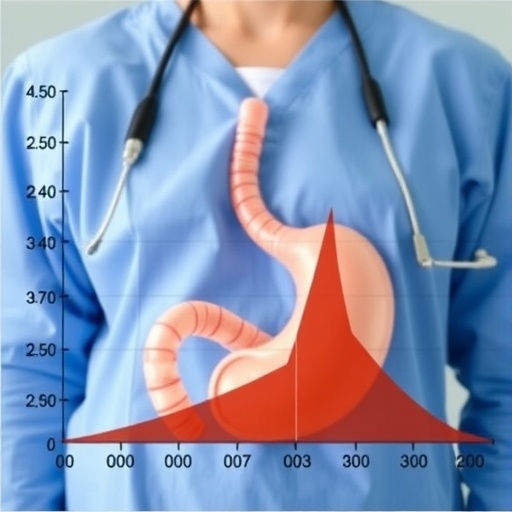In the rapidly evolving field of minimally invasive surgery, the management of gastric submucosal tumors (GSMTs) presents ongoing challenges, particularly concerning postoperative complications such as intra-abdominal infections (IAI). A groundbreaking study recently published in BioMedical Engineering OnLine introduces a sophisticated predictive tool that promises to refine risk assessment and enhance patient outcomes following endoscopic full-thickness resection (EFR) of GSMTs. This pioneering research offers a nomogram model that integrates critical clinical factors to precisely estimate the likelihood of IAI, heralding a new era in personalized surgical care.
EFR has emerged as a preferred technique for the removal of gastric submucosal tumors due to its minimally invasive nature and preservation of gastric structure and function. However, despite its advantages, the risk of postoperative complications remains a significant concern, with IAI being one of the most severe and potentially life-threatening issues. Detecting which patients are most susceptible to these infections before surgery could transform preventative strategies, but until now, predictive tools with robust accuracy have been lacking.
The research team conducted a comprehensive retrospective analysis of 240 patients who underwent EFR for GSMTs between January 2018 and July 2023. This extensive dataset enabled a detailed examination of clinical variables associated with the onset of IAI during postoperative hospitalization. Among these patients, 14 developed IAI, providing a vital contrast group to identify statistically significant risk factors through rigorous statistical modeling and regression analysis.
Three independent risk factors emerged as the pillars of risk prediction: patient age, preoperative C-reactive protein to albumin ratio (CAR), and surgical duration. Age is a well-known determinant of surgical risk, often correlating with diminished physiological reserves and immune function. The study’s identification of CAR as a critical biomarker underscores the role of systemic inflammation and nutritional status in postoperative recovery. Meanwhile, prolonged surgical time reflects procedural complexity and may increase exposure to pathogens, thus elevating IAI risk.
Leveraging these insights, the researchers constructed a nomogram model—a graphical representation translating statistical predictive factors into a user-friendly interface for clinical application. This model calculates an individual’s risk by allocating scores to each factor, facilitating nuanced risk stratification. In validation tests, the model demonstrated outstanding discriminative capacity with an area under the curve (AUC) of 0.968, which indicates near-perfect accuracy in distinguishing between patients who will or will not develop IAI.
The robustness of the model was further confirmed using the Hosmer–Lemeshow goodness-of-fit test, which showed excellent agreement between predicted and observed infection rates. Such high concordance supports the reliability of the nomogram as a practical decision-support tool, enhancing surgical planning and perioperative management by identifying high-risk individuals who may benefit from targeted preventive interventions.
Beyond statistical validation, the clinical utility of the nomogram was assessed through decision curve analysis (DCA). This evaluation revealed that the model provides superior net benefit across a broad range of risk thresholds, confirming its potential to optimize clinical decision-making. This is crucial in tailoring prophylactic measures, such as antibiotic administration, postoperative monitoring intensity, or patient counseling, thereby reducing unnecessary treatment and associated healthcare costs.
Importantly, this research highlights the interplay between age, inflammatory status, and operative time, underscoring the multifactorial nature of postoperative infections. It also reflects advancements in biomarker utilization, leveraging easily obtainable preoperative blood parameters to inform complex risk profiles. Such integration of clinical and biochemical data represents a significant evolution from traditional surgical risk assessment models.
The advent of this nomogram model aligns with the broader trend towards precision medicine in surgical oncology. By accurately categorizing patients based on their individualized risk, clinicians can enhance the safety of EFR procedures, potentially reducing morbidity and improving long-term outcomes. Moreover, this approach may serve as a prototype for predictive modeling in other gastrointestinal surgeries, expanding its impact.
Researchers emphasize that while the model exhibits high predictive performance, prospective validation in diverse populations and clinical settings is essential to confirm its generalizability. Future studies may also explore the integration of additional biomarkers or imaging features to further refine risk estimation, as well as the development of automated digital tools to facilitate nomogram use in busy clinical workflows.
In summary, the study spearheaded by Wang, Huang, and Zhao represents a significant leap forward in the perioperative care of patients undergoing endoscopic full-thickness resection for gastric submucosal tumors. Their nomogram model effectively synthesizes patient age, preoperative CAR, and surgical duration into a powerful predictive instrument with strong statistical and clinical validation. This clinically actionable tool holds promise to reduce the burden of intra-abdominal infections, enhance personalized patient care, and pave the way for future innovations in surgical risk modeling.
As minimally invasive techniques continue to advance, predictive analytics such as this nomogram model will be indispensable in bridging the gap between surgical innovation and patient safety. By identifying patients at heightened risk for complications preemptively, surgeons can implement tailored strategies that not only improve outcomes but also optimize resource allocation within increasingly strained healthcare systems.
The convergence of clinical data science and surgical expertise demonstrated in this study exemplifies the transformative potential of interdisciplinary research in medicine. With continued validation and refinement, such predictive models are poised to become standard tools in the surgical armamentarium, reaffirming the commitment to precision, safety, and excellence in patient care.
Subject of Research: Risk prediction of intra-abdominal infection post endoscopic full-thickness resection of gastric submucosal tumors.
Article Title: A nomogram prediction model for the risk of intra-abdominal infection after endoscopic full-thickness resection of gastric submucosal tumors.
Article References:
Wang, L., Huang, W. & Zhao, Jj. A nomogram prediction model for the risk of intra-abdominal infection after endoscopic full-thickness resection of gastric submucosal tumors. BioMed Eng OnLine 24, 131 (2025). https://doi.org/10.1186/s12938-025-01455-9
Image Credits: AI Generated
DOI: 05 November 2025
Tags: advancements in surgical predictive toolsendoscopic full-thickness resection outcomesgastric submucosal tumors surgeryinfection risk assessmentintra-abdominal infections post-surgeryminimally invasive gastric surgerypatient outcomes following gastric surgerypersonalized surgical care innovationspostoperative complications in gastric surgerypredictive nomogram for infectionsretrospective analysis of surgical patientsrisk factors for intra-abdominal infections





